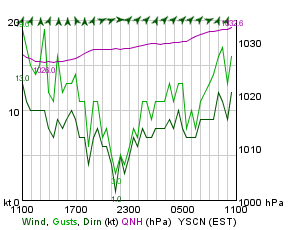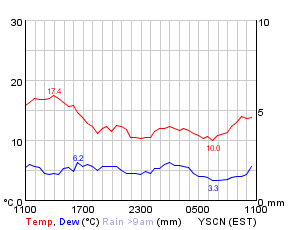Flying Training
Lesson 32: Crosswind Circuits 1
Sunday 6 August 2006, 4.00pm with Kerry Scott in Warrior VH-PBS

Weather: scattered cloud, hazy, 10-knot southerly wind
Alexander's soccer trials this afternoon were cancelled and postponed till 3pm next Sunday. Since this was exactly when I'd booked my next lesson, I called Curtis on the offchance that a 4pm slot might be possible. Luckily Kerry was free, although there were no spare Citabrias, so I quickly memorised a few useful speeds for the Warrior, gave the boys some lunch and headed off.
Although there had been some decent crosswinds earlier in the day, at first it looked as though the wind had dropped, and Kerry planned a trip to the training area to do some turns and stalls, followed by some circuits. However the wind must have increased slightly, because Kerry decided to stay in the circuit, making this a first crosswind circuit lesson. It served a secondary purpose of familiarisation with the Warrior, and by extension any light aircraft where you hold a yoke in the left hand and control the throttle with the right. As Kerry reminded me, "This is what you'll be flying more often than not."

Kerry was amused by my taxiing because I kept using the yoke as a steering wheel, which naturally would be completely ineffective! (I understand this is a common problem.) The rudder pedals also felt different, probably not helped by the fact that they were a little far away. The previous student must have had long legs. The thing is the distance from the control yoke felt comfortable. Unless there is a separate rudder pedal adjustment I'm going to have to get used to the yoke being rather close.
We turned into the wind at the run-up bay for runway 24 and followed the checklist. This includes switching to the tank with the most fuel (having previously started and taxiied on the less full tank) so that you know you don't have a blockage in either tank, and switching on the electric fuel pump (which Kerry had switched off for taxiing).
Take-off was straightforward - keep straight, centralise the yoke (having taxiied with it pretty well full back to keep the weight off the nosewheel) and hold some into-wind aileron until just before lift-off, at around 70 knots. After lift-off in a crosswind the aircraft will naturally crab into the wind, so it might need some opposite rudder to keep straight. Trim for 75 knots.
Then back to the normal circuits. At 800 feet (when the tower is active) make a gentle climbing turn onto crosswind, check your track is square to the runway, then another climbing turn onto downwind. Hold the nose down to level off at 1300 feet, allow the aircraft to accelerate to around 90 knots, throttle back and trim. (The trim wheel needs quite a bit of turning at this point.) Heading was towards Sydney, barely visible in the haze, and correct spacing from the runway in the Warrior is halfway along the aileron.
Now it's time for the BUMFISH checks, including fuel pump (which we leave on in the circuit) and fuel selector to fullest tank. Make a downwind call ("Papa Bravo Sierra, downwind for 24, touch and go"), and respond to the tower's instructions, eg "Number two, behind the Cessna, Papa Bravo Sierra". Watch for the runway to pass behind the wing, count one, two, then carby heat to hot, throttle back, one stage of flap and turn base.
Up till now it was basically familiarisation with the aircraft. Now came the purpose of the lesson. This approach was made crabbed into wind to keep the aircraft tracking down the centreline, and then once over the threshold we (and I do mean 'we' as Kerry was on the controls with me) transitioned to left wing down and right rudder to keep straight. Flare, hold off, and then the into-wind mainwheel touched first, then the other main, then the nosewheel. I concentrated on keeping straight while Kerry raised the flaps, then full throttle and round again.
We made perhaps three approaches using the crab technique, keeping the aircraft tracking down the centreline of the runway with the nose pointed into wind. I learned (again) to arrest a too-quick descent rate with a touch of throttle. We used full flap on one of these approaches and Kerry reminded me to hold the nose down to arrest the consequent tendency to 'balloon'. I also learned (through Kerry's raised voice!) not to let the speed get too low. The Warrior stalls at 50 knots clean, and the minimum approach speed is 65 knots (63 knots with full flap).
For the last couple of circuits we switched to the wing-down method for final approach. Interestingly this felt slightly more natural to me but it's not passenger-friendly as it causes them to slip sideways in their seats. It also helps if you can reach the rudder pedals at full travel! One thing to be aware of in a low-wing aircraft like the Warrior is that you don't have the wing too low at touchdown, or it could connect with the ground, which could really spoil your day.
By the end of the lesson I began to feel I was catching up with the aircraft, but at no time did I feel ahead of it. I'm also concerned that it's now been a month since my last lesson in a Citabria and I may be losing my touch there.

Kerry did remind me that the Warrior was a fun aircraft to fly (hmmm...) and also not to beat myself up because I made mistakes. "Just relax and enjoy it," she said, and she has a point.
Next lesson will hopefully be back in a Citabria, for precautionary search and landing, or crosswind circuits again if the weather's suitable.
Photos
Here's something you don't see every day - a blimp, landing.
 Holden blimp |
 Blimp and moon |
 Blimp on final |
 Blimp on final |
 Blimp on final |
 Blimp over taxiway |
 Blimp and Citabria |
 Touchdown |
 Blimp and Warrior |
 Blimp crew |
Meanwhile my colleague Andrew Miskelly spent the day at Temora and donated these pictures:
 F-18s |
 F-18 |
 Spitfire |
 F-18 |
 F-18, Boomerang, Spitfire |
Kerry's feedback:
Yes, saw your booking. Sounds like a good plan.
Meantime, on your write-up, a couple of points:-
1) The seat is adjustable... if the rudder pedals were too far away, you should have said something......arrggghh!
2) The more correct word for aircraft behaviour after takeoff is 'crab' into wind. Weathercock is probably not the best term, as it will not "turn completely to the wind direction". You could imagine the horror if we had a direct crosswind (ie. 90 deg ) and the aircraft faced 90 deg off the runway heading immediately after lift off!!! The aircraft will turn towards the wind direction because it's blowin' on the side of the fuselage, but the pilot 'controls' how much the aircraft's crab-angle will be, to ensure inertia of aircraft flight direction is straight.
3) When the tower is active, turn crosswind at 500ft AGL. When CTAF, turn crosswind at 700ft AGL [ie 300ft below circuit height].
4) Spacing for base - either 2 chords of wing from threshold / or 45 deg, but adjusted, depending on wind conditions - ie. turn earlier if bigger tailwind ('downwind').
5) Technique on Final (crab or sideslip). Remember you will lose more height on a side slip (higher RoD), so if a crosswind from say 45 deg at 25kts, a fair amt of "headwind component", and may have to use pwr to ensure you don't get too low. For Crabbing, on straightening up the aircraft, the "into-wind" wing doesn't necessarily need to be that much lower than the other.... just enough to stop the crosswind from getting underneath it, lifting it and consequently causing the a/c to drift over to one side of the runway.
6) I'm glad you had a good time in the Warrior... and certainly hope you take a deep breath, take my advice, and relax & enjoy your flying lessons a little more... rather than trying always to conquer the lesson :-)
See you next weekend.
